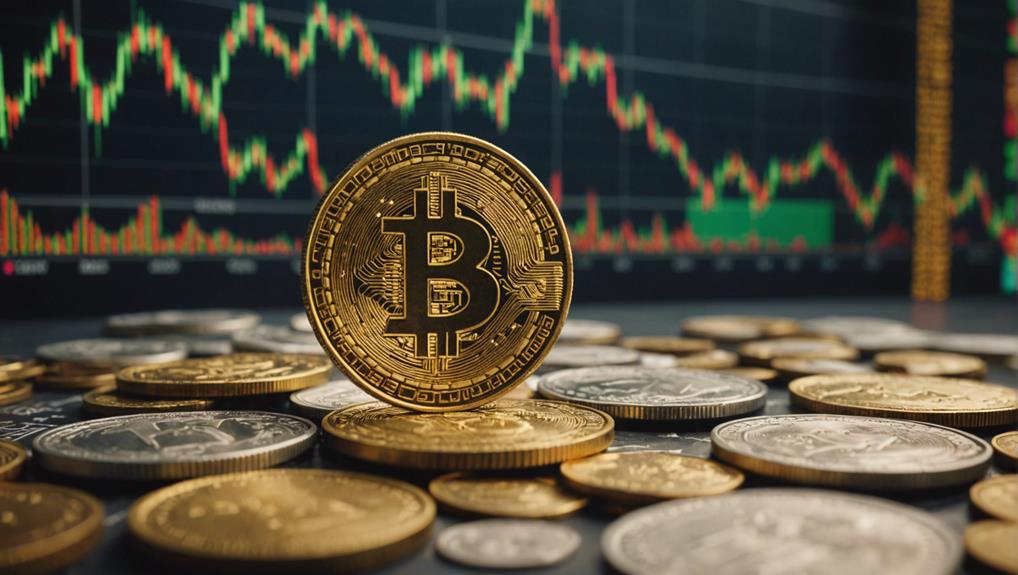Gold has historically served as a reliable inflation hedge, helping preserve your purchasing power when currency values decline. As inflation erodes the value of money, gold typically maintains or even increases in value. It’s considered a safe haven during economic uncertainty, protecting against the volatility seen in other investments like stocks or bonds. Historical data, including its appreciation during the 1970s inflation spike and the 2008 financial crisis, underscore gold’s role in safeguarding assets. Diversifying your investments to include gold can effectively manage financial risks. Exploring more about gold could reveal deeper insights into its enduring relevance in protecting wealth.
Understanding Inflation and Gold

Inflation erodes your purchasing power, but gold often acts as a resilient safeguard against this decline. Essentially, as prices of goods and services increase, the value of currency falls. You’ll find that what your money buys today mightn’t stretch as far tomorrow.
Yet, gold typically maintains its value or even appreciates during such times. This attribute makes it a preferred choice for those looking to protect their wealth from the silent creep of inflation. It’s not merely about having shiny coins or bars in a safe; it’s about securing your financial future against the unpredictable swings of the economy.
Investing in gold can be a strategic move to ensure your savings remain robust.
Historical Performance of Gold

Gold’s historical performance has demonstrated its reliability as an investment, especially during periods of economic uncertainty. You’ll find that during times when inflation spikes, gold often becomes a preferred asset for protection.
For instance, in the 1970s, when inflation soared, the price of gold significantly increased, providing substantial returns to those holding it. Again in the 2008 financial crisis, as stocks plummeted and economic stability was questioned, gold prices surged. This pattern underscores gold’s reputation as a ‘safe haven’ during turbulent financial times.
It’s not only about immediate gains; gold has maintained its value over the long term, showing less volatility compared to many other assets. This steadiness makes it a compelling component of a diversified investment portfolio.
Gold Vs. Other Investments

As you consider the role of gold in your investment portfolio, it’s important to compare it with other investment options such as stocks, bonds, and real estate.
Each asset class has its unique characteristics and risk profiles that can influence your returns, especially during periods of inflation.
Understanding these differences will help you make more informed decisions about where to allocate your funds.
Gold Vs. Stocks
When comparing investment options, you’ll find that gold often behaves differently than stocks during economic fluctuations. Gold is typically viewed as a safe haven when markets are volatile. Its price doesn’t usually move in tandem with stock markets and sometimes even increases when stocks fall. This can provide a balancing effect in your portfolio.
On the flip side, stocks are generally more closely linked to economic conditions and corporate performance, offering higher potential returns compared to gold but with increased volatility. You’re exposed to market ups and downs, which can erode wealth quickly during downturns.
Comparing Bonds and Gold
Let’s now compare how investing in bonds stacks up against gold. Bonds are generally considered a safer investment compared to gold because they offer predictable returns in the form of interest payments. Nevertheless, during periods of high inflation, the fixed returns from bonds mightn’t hold up well, as their purchasing power can diminish.
On the other hand, gold has historically been seen as a hedge against inflation. Its value tends to rise when the cost of living increases, protecting your investment from losing its real value. Nonetheless, gold doesn’t produce any income like bonds do through interest payments, which can make it less appealing during stable economic times.
Thus, your choice might depend on your outlook on economic conditions and your risk tolerance.
Gold and Real Estate
You might find that both gold and real estate offer unique benefits as investment options to hedge against inflation.
Gold is often seen as a safe haven during times of economic uncertainty, maintaining its value as the purchasing power of national currencies may decline.
On the flip side, real estate can provide practical value and potential rental income, alongside appreciation in a buoyant market. Nevertheless, real estate involves higher initial costs and maintenance expenses, unlike gold, which is more liquid and requires less upkeep.
Both assets are subject to market fluctuations and geopolitical factors, yet historically, they’ve shown resilience against inflation. Ultimately, your choice depends on your financial goals, risk tolerance, and investment horizon.
Factors Affecting Gold Prices

Several factors significantly impact gold prices. These include geopolitical tensions, inflation rates, and currency values. These elements interact in complex ways to drive market dynamics. Geopolitical tensions often drive up gold prices as it becomes a safe haven during international conflicts. Inflation rates can lead to increased demand for gold as it is seen as a stable investment. Currency values, especially a weaker dollar, can enhance demand for gold by making it cheaper for holders of other currencies. Additionally, central bank policies, such as decisions on interest rates and monetary supply, can also sway gold prices as investors seek secure places to store value.
It’s important to consider these factors and how they influence gold prices when analyzing market trends and making investment decisions. Understanding the relationships between geopolitical tensions, inflation rates, currency values, and central bank policies can provide valuable insights into the behavior of gold prices.
Real-Life Examples of Gold Investment

As you consider gold as a viable investment option, it’s crucial to examine historical gold price trends which unveil how its value has responded to different economic conditions. Successful gold investment strategies often depend on timing and market understanding, highlighting the significance of both in achieving desirable outcomes.
These real-life examples can steer you in making informed decisions about incorporating gold into your investment portfolio.
Historic Gold Price Trends
Studying historic gold price trends shows how investors often turn to this precious metal during times of economic uncertainty. You can see the appeal when you look at specific instances where gold proved its worth:
- 1970s Oil Crisis: Gold prices soared as inflation spiked, highlighting its protective role.
- 2008 Financial Crisis: As stock markets crashed, gold prices climbed, serving as a safe haven.
- 2011 Eurozone Debt Crisis: Investors flocked to gold, driving up its price during regional financial instability.
- 2020 COVID-19 Pandemic: With global economies in disarray, gold prices reached record highs.
These examples clearly illustrate gold’s reputation as a reliable asset in turbulent times, reinforcing its value in your investment portfolio.
Successful Gold Investment Strategies
Understanding gold’s historical stability, let’s explore real-life examples of successful gold investment strategies.
You’ve likely heard of billionaire investors like George Soros and John Paulson who’ve greatly benefited from gold investments. Soros famously made a substantial profit by investing in gold during the 2008 financial crisis, recognizing early on that it would be a safe haven amid market turmoil.
Likewise, Paulson earned billions in 2010 by investing in gold funds, betting on gold prices rising due to economic instability. Their strategies often involved timing the market to buy when prices were low and selling when they peaked, highlighting the importance of market awareness and timing in gold investments.
Strategies for Investing in Gold

Investors can choose from several strategies to integrate gold into their portfolios, each offering distinct advantages and considerations. Here are some popular methods:
- Physical Gold: Purchasing actual gold bars, coins, or jewelry.
- Gold ETFs (Exchange-Traded Funds): These funds replicate the price of gold, providing ease of trading without physical storage issues.
- Gold Mining Stocks: Investing in companies that extract gold, linking returns to gold prices and mining company performance.
- Gold Mutual Funds: These funds invest in a variety of gold-related assets, offering diversification within the gold sector.
You’ll find that each option has its trade-offs between liquidity, costs, and exposure to gold’s price movements. Consider your investment goals and risk tolerance to choose the right strategy.
Future Outlook on Gold and Inflation

Looking ahead, gold’s role as an inflation hedge remains an essential consideration for your investment strategy. As you plan for the future, understanding the dynamics between gold and inflation is vital.
Historically, gold has often increased in value during high inflation periods, serving as a robust store of value when currencies falter. Experts predict that with ongoing economic uncertainties and potential inflation spikes, gold could continue to be a safe haven.
It’s important to bear in mind that gold’s performance isn’t always predictable. Diversifying your investments and continuously monitoring market conditions will help you manage risks effectively.
Stay informed about global economic trends and central bank policies, as these factors significantly influence inflation and, consequently, gold prices.
Conclusion
Gold emerges as a beacon in the stormy skies of inflation, maintaining its luster as a steadfast safeguard of wealth. This precious metal has consistently transcended the fleeting promises of volatile investments, especially during periods when economic uncertainty casts a long shadow. As you weigh your financial strategies, remember that gold’s historical resilience is amplified by present-day geopolitical tensions and market fluctuations, which continually sculpt its value.
Turning to gold not only diversifies your investment portfolio but also places you in the driver’s seat, giving you more control over your financial destiny. This is particularly crucial in a system where banks and traditional financial institutions often cater more to the affluent, leaving everyday investors navigating the terrain alone. Skepticism towards these entities grows as they frequently seem disconnected from the needs of the average person, influenced heavily by political and corporate agendas.
In this light, embracing gold as part of your investment strategy isn’t just prudent; it’s a form of empowerment. It’s stepping away from a banking system that doesn’t always have your best interests at heart and from politicians whose policies may fluctuate as wildly as the markets they impact. When you invest in gold, you’re not just protecting your assets against inflation, you’re reclaiming control from systems and structures that aren’t designed to serve the everyday investor.
To truly understand the power and potential of gold to fortify your financial future against the uncertainties of inflation, request your free gold information kit today. This kit isn’t just a collection of facts; it’s the first step towards financial liberation and resilience.
The Gold Information Network
11900 Biscayne Blvd, Ste 127B, Miami, FL 33181
(305) 449-9094
source https://rondewitt.com/golds-role-as-an-inflation-hedge/
from Blogger https://ift.tt/SZDaQ4c
via IFTTT
